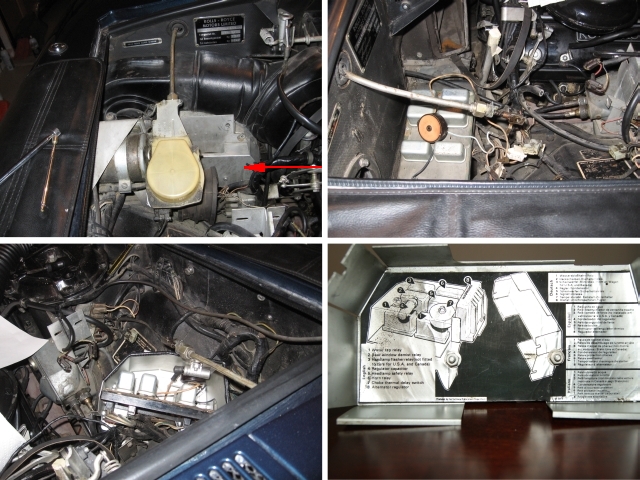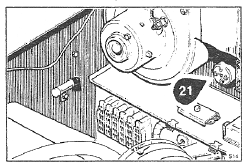| Author | Message | ||
Jeff Young Prolific User Username: jeyjey Post Number: 114 Registered: 10-2010 |
My '79 T2 (37222) is running quite well aside from one problem. On cold mornings it tends to stall at one of the two right-hand bends at 1.6km and 2.0km from my house. Once restarted, it will be fine for the rest of the drive. About 0.8km from the house is a T-junction (actually the end of my drive). No issues there. Some time ago Paul suggested weak engine mounts allowing too much flexure in the throttle linkage. But the bends are slow enough that my foot is off the gas and on the brake, so the throttle linkage should be against the idle stop screw. (I did check the idle speed to make sure it is set against the stop, and not at some point above that held by a bind in the linkage or pedal travel limit. So it seems to me that the linkage is out of play.) The two right-hand bends are also in opposite directions, and it seems if it was an engine-moving issue, that it would only happen in one direction. I thought it might be a weakener issue (perhaps coming on a little early and lowering the idle too much before the intake was fully warm). That might explain why I have no issues at the 0.8km T-junction (no weakener yet). But I've disconnected the weakener (shorted the connector at the inlet temp sensor), and it still happens at the 1.6km or 2.0km bend. (FWIW, my idle between part-warm and fully-warm is much better without the weakener, so there is either an issue with the weakener or the temp switch -- or the previous owner set the idle speed with the weakener off. In any case, the weakener is now disabled, and the idle speed is if anything a tad high, so I think I can save that issue for a later date.) Any chance it's the extra load of the power steering pump or something? Any other ideas? Thanks, Jeff. | ||
Paul Yorke Grand Master Username: paul_yorke Post Number: 976 Registered: 6-2006 |
Hi Jeff, It sounds as though it is idling a tad too slow so the extra load of the PAS is causing it to stall. What happens if you let the car run for a couple of minutes before starting out? Possibly adjust the fast idle cam so it give a few more revs until the choke comes off fully. Possibly the choke is coming off a little early (bi-metallic spring adjustment). | ||
Jeff Young Prolific User Username: jeyjey Post Number: 115 Registered: 10-2010 |
Hi Paul, I tried letting the car warm up a bit before starting out earlier in my attempt to diagnose this -- but now I can't remember what the result was.  I'll have to re-run that experiment.... Thanks, Jeff | ||
Jeff Young Prolific User Username: jeyjey Post Number: 116 Registered: 10-2010 |
3 minute warm-up: no stall. I'll give the fast-idle cam a tweak. Thanks again, Jeff. | ||
Omar M. Shams Grand Master Username: omar Post Number: 327 Registered: 4-2009 |
Dear Jeff, I once had the same issue. My poblem was fuel starvation at maximum demand conditions and only one side of the fuel pump working. Check that both pumps are working, not just one side. | ||
Jeff Young Prolific User Username: jeyjey Post Number: 117 Registered: 10-2010 |
Hi Omar, Yep, I'll check that too once I can get the car up on the lift. (I've another car, nicknamed "Calamity Jane", that's currently hogging the lift.) Cheers, Jeff. | ||
Geoff Wootton Prolific User Username: dounraey Post Number: 116 Registered: 5-2012 |
Jeff I had exactly the thing happen to my 74 SY1. The problem turned out to be a faulty choke solenoid. I had initially checked it with a meter in-situ and it looked ok; there was continuity through the coil. However on removing the solenoid and putting 12 volts through it I found the magnetic field was very weak; barely enough to lift a small spanner. What had happened was the insulation had worn away where the wires emerge from the cover plate and when under load current was leaking to earth, reducing the magnetic field and thus allowing the butterfly valve to flutter. After repairing the solenoid I found it is in fact a very strong electromagnet, quite capable of lifting a 2 pound weight. I documented my repair here: http://au.rrforums.net/forum/messages/17001/13329.html The photos show how the insulation of the wires wear away. In fact the one actually snapped off completely as I was checking it off the car. It is certainly worth checking your choke solenoid, off the car, to make sure the magnetic field is strong enough to keep the butterfly valve closed during that initial warm up period. | ||
Jeff Young Prolific User Username: jeyjey Post Number: 118 Registered: 10-2010 |
Hi Geoff, He he... I'm very familiar with the choke solenoid -- although mine had the opposite problem and stayed on for too long due to a faulty thermal delay unit. That's an interesting thought though: I wonder if the previous owner lowered the fast idle on my car in an attempt to compensate for the choke being stuck closed for too long. (The thermal delay unit was one of the first things I fixed after purchasing the car.) Cheers, Jeff. | ||
Bob Reynolds Experienced User Username: bobreynolds Post Number: 39 Registered: 8-2012 |
Whereabouts is the Thermal Delay Unit? And how long should it operate for? | ||
Jeff Young Prolific User Username: jeyjey Post Number: 119 Registered: 10-2010 |
It's on the firewall/bulkhead under the fan-to-condensor ducting near the 3 A/C relays. Little round bakelite-looking thing, about 2" in diameter and 3/4" thick. It should only come on in sub-zero temperatures. Not sure how long it sould stay on at colder temps, but probably on the order of 30 seconds when it's only just below freezing. Jeff. | ||
Geoff Wootton Prolific User Username: dounraey Post Number: 118 Registered: 5-2012 |
Bob, For the SY1 cars, the engineers at Rolls Royce decided to place the thermal delay unit in the relay box along with various other relays and make them as inaccessible as possible. The manual states to gain access, simply remove a few set screws, pull the relay box forward and flip it upwards. What they omit to tell you is the box is obscured by the cruise control belows, windscreen wiper motor, windscreen washer bottle and accelerator linkage mounting bracket. Even if you remove all these obstructions, you cannot pull the relay box far enough forward to flip it up, as the heater duct gets in the way. In my experience, the best way to gain access is to remove the heater duct and go in from the top. Here are some photos that I took whilst carrying out some work in that area.  Top Left: The red arrow points to the relay box. The thermal delay unit is located inside the box. This photo was taken with the windscreen washer bottle and CAV voltage regulator removed. Top Right: The relay box base with the thermal delay unit (scintilla switch) pictured in the centre of the photo. This is normally bolted to the top of the relay box. Lower Left: A view of the relay box tilted forward. The scintilla switch can just be seen, behind the regulator capacitor. Note: I doubt there is enough clearance to remove some of the relays without removing the top of the relay box first. Lower right: A map of the components is provided on the reverse of the front cover. Geoff. | ||
Bob Reynolds Experienced User Username: bobreynolds Post Number: 40 Registered: 8-2012 |
Thank you very much for taking the trouble to post. That relay box is something I have yet to explore! At least here in the UK the wiper motor is on the other side, but from what you say that doesn't appear to make it any easier.  | ||
Jeff Young Prolific User Username: jeyjey Post Number: 121 Registered: 10-2010 |
Yikes, that looks a right pain in the rear. The SSII/T2 has the CAV in the trunk, and 3 relays and the Scintilla switch mounted "naked" on the bulkhead.  21 is the Scintilla switch, the compressor & fan fuses are below it, and the first of the 3 relays can be seen just to the right of the fuses. Jeff. | ||
Mark Aldridge Frequent User Username: mark_aldridge Post Number: 97 Registered: 10-2008 |
I posted a thermal switch problem on my Spirit recently . I still have the choke solenoid disconnected, but the car started easily today at -3 centigrade. Mark | ||
Jeff Young Prolific User Username: jeyjey Post Number: 122 Registered: 10-2010 |
OK, so I gave the fast idle screw about 3/8 of a turn (which according to the manual should be about 60 RPM). No stall on two tests. But it is a little over-eager moving off now when cold. It appears that what would be ideal is a slower ramp on the fast-idle cam, rather than more displacement on the fast-idle screw. Could that be achieved by restricting the stove-pipe flow a bit more, or am I asking for trouble there? Or was 60 RPM way more than I needed? (The fault isn't 100% repeatable, and it's a somewhat dangerous corner to stall on, so I'd rather not narrow it down by trail-and-error.) Thanks, Jeff. | ||
Paul Yorke Grand Master Username: paul_yorke Post Number: 984 Registered: 6-2006 |
stove pipe restricting is not a way forward . the bi metallic spring adjusts that rate. if you give it one kick before putting it in gear it it might help . | ||
Jeff Young Prolific User Username: jeyjey Post Number: 123 Registered: 10-2010 |
Thanks, Paul. I disconnected the stove pipe and removed the automatic choke cover. It was set to 1/2 notch lean of the scratch mark on the dial. I reset it to 1 notch rich of the scratch mark, and lowered the fast idle screw by 1/8 of a turn. Seems to give slightly better results (although it's also a few degrees warmer than it was this morning, so it's not exactly apples to apples). BTW, if anyone resets their automatic choke, don't panic (like I did) when you think you've stripped the little 3BA bolt that holds the adjustment. The plate is not actually threaded; you have to remove the choke solenoid and reach a finger in behind to hold the nut still while you nip up the bolt. Cheers, Jeff. |